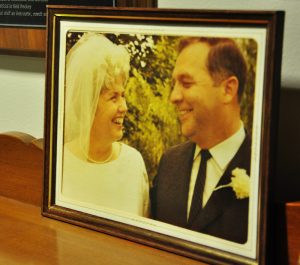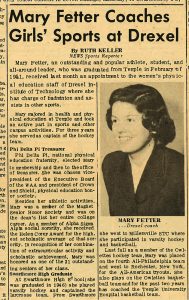Mementos from Mary Semanik’s legendary career as a star athlete, coach and longtime director of women’s athletics at Drexel University adorn the walls of her cozy apartment in a Newtown Square, Pennsylvania, retirement community.
Plaques and certificates attest to her numerous milestones as a field hockey and lacrosse player: 1978 inductee into the Temple University Sports Hall of Fame, 10-year member of the All-American lacrosse team, 1985 inductee into the Pennsylvania Sports Hall of Fame and 1996 inductee into the National Lacrosse Hall of Fame.
Occupying the most prominent position in Semanik’s living room are portraits of herself with her late husband John Semanik ’56, director of Drexel Athletics from 1962 to 1991, which were commissioned by Drexel when the Semaniks became members of the University’s Athletic Hall of Fame in 1994.
The care with which these honors are displayed belies Semanik’s modesty when she talks about the accomplishments they represent. The game she most remembers, for example, is one in which she accidentally scored a goal for the opposing team. And of her prominent role in Philadelphia’s lacrosse scene, she says: “I had so many good people around me. All I had to do was my job, and they did the rest of it.”
Semanik is equally humble about her tenure at Drexel, where she began teaching and coaching in the 1950s while still a student at Temple and then served alongside her husband in administration from 1965 to 1991. She prefers to emphasize John’s leadership in driving the rapid progress that Drexel Athletics enjoyed during that time.
“I was behind him pushing, but John was the boss,” she says, laughingly adding, “do you hear me, honey?” as she glances heavenward. John Semanik, a former Drexel football player, returned to Drexel as athletic director in 1962 after working for the Federal Reserve Bank for several years. His obituary in The Philadelphia Inquirer recounts that “he was ahead of his time in recognizing the importance of sports economics.” He drew on his financial background to oversee key changes in the department, like taking the program Division I, moving the Dragons from the Middle Atlantic Conference to the East Coast Conference and adding the University’s Physical Education Athletic Center — now known as the Daskalakis Athletic Center (DAC).
Semanik calls her husband a leader, someone who “got things done.”
Many of Semanik’s former colleagues, however, insist that she is a leader in her own right, one who advocated for women athletes and coaches as she helped guide Drexel’s athletic program through momentous changes in women’s collegiate sports, including the 1972 introduction of Title IX legislation and the transition in governance from the Association for Intercollegiate Athletics for Women (AIAW) to the NCAA Division I for women.
“It was quite the time of growth,” remembers Carol Kashow, director of athletics at the John Jay College of Criminal Justice and former Drexel softball and badminton coach. “Mrs. Semanik had a vision for how we were going to move forward in a way that was within the school’s means but made sure that all students had equal opportunity and equal support.”
Now, nearly 25 years after her retirement, Semanik is helping to transform Drexel Athletics yet again by making a $1 million commitment from her husband’s and her estate to the program. Her gift will endow the first named coaching position of a women’s team at the University, as well as provide unrestricted support.
The Mary Semanik Head Coach of Women’s Lacrosse is currently held by Hannah Rudloff, MS ’13. Eric Zillmer, director of athletics and Carl R. Pacifico Professor of Neuropsychology at Drexel, says that this endowed position will provide lasting resources that will allow Rudloff to further strengthen what is poised to become a Top 30 program. Zillmer adds that Semanik “forged women’s athletics at Drexel,” helping to lay the groundwork for a program that was ranked No. 1 nationally in gender equity in the March 2002 issue of U.S. News and World Report.
“At one of the first East Coast Conference swim championships that Drexel hosted, the women’s team won and, of course, they threw me into the pool since that was what you did to your coach. Mary was there, too, handing out trophies with the conference commissioner, and the girls were so excited that they threw her in as well. Immediately after they’d done it, they thought, ‘Oh my gosh, can she swim?’ Luckily, Mary could, and she was a terrific sport about it.”
— Barbara Kilgour Cleghorn, former Drexel swim coach and director of women’s athletics
Such superlatives were a long way away, however, when Semanik first arrived at Drexel. Resources were scarce across the board but particularly for women athletes.
“I used to teach phys-ed classes in the [Philadelphia] Armory,” she recalls. “We’d go in for dance, and there would be puddles of beer all over the floor because there had been a union meeting there the night before. And women’s lacrosse used to have very little money to spend. We would have to re-use the previous team’s shoes.”
The transition to Division I and the passage of Title IX brought in an influx of funding that allowed the Semaniks to expand both men’s and women’s programs. As equal access to federally funded educational programming — including collegiate athletics — became the law, Semanik worked with her husband to increase opportunities for Drexel’s women athletes, including introducing new sports, improving equipment and facilities, and earmarking a budget for recruiting.
“People realized women could play hard sports, and they should be given that opportunity,” Semanik recalls. “We started getting the financial backing we needed.”
Full-time coaching appointments were another area of investment, and the Semaniks, Kashow says, “were game to take a chance on several young coaches.” Mary Semanik was especially intent on giving female applicants a fair shot at coaching positions, recalls Drexel Athletics Hall-of-Fame member Barbara Kilgour Cleghorn.
“When the NCAA took over from the AIAW,” Cleghorn says, “women’s college sports became better resourced and more sincerely recognized, and started attracting men and women coaches. Mary wasn’t opposed to hiring men, but she really tried to give women the opportunity to make a place for themselves in this new structure.”
Cleghorn experienced firsthand the power of Semanik’s advocacy. Hired to be an assistant swim coach in the 1970s, Cleghorn advanced to become assistant women’s athletic director and, after Semanik’s retirement, director of women’s athletics. She later moved on to high-level athletics administration positions at Temple, Southern Connecticut State and West Chester universities.
In addition to the opportunities Semanik gave them, the coaches who worked under her also treasured her mentorship. Lillian Haas, Drexel Athletics Hall-of-Famer and one of the winningest coaches in Drexel women’s basketball history, says: “Mary would allow you to grow at your own pace and gave you the freedom to make your own decisions about your teaching and coaching.”
“On occasion I would bring my dog to school, and Mary allowed it. What boss does that and how can you not salute a boss who likes animals and sports?”
— Lillian Haas, former Drexel head coach of women’s basketball and associate professor of physical education at Drexel
Always at the core of Semanik’s commitment to women’s athletics were the generations of students who went through the program during her career at Drexel. Even after she left coaching to enter administration, she continued to maintain a close relationship with the student-athletes.
Renee Bucci Alshouse ’88, a former field hockey and lacrosse player and Drexel Athletics Hall-of-Famer, remembers being impressed that Semanik always knew the names of her and her peers and made a point to talk to them: “Mrs. Semanik had her finger on the pulse of everything that was going on,” she says, “and she was aware of the student-athletes’ accomplishments and struggles.”
“When Mary and I were hired at Drexel, the men and women had separate gyms, no co-ed gym classes, and the staff members had men-only and women-only eating facilities. Mary and I used to enjoy eating in the men’s facility just to see if we could. No one ever said a thing.”
— Kathy Frey, former Drexel swim instructor and assistant director of women’s physical education at Drexel
One of Drexel Senior Associate Athletic Director Laura White’s fondest memories from when she was the coach of women’s tennis was Semanik’s frequent presence at her matches: “It meant so much to me and to my players,” White says. “You could see how excited they were that Mary was there supporting and encouraging them.”
Semanik’s recent gift was motivated by her wish to leave an enduring legacy, with her husband, to benefit future generations of Drexel’s student-athletes. She hopes it will allow Drexel Athletics to leverage not only the program’s rising success but also the historic changes in women’s college athletics that she has seen unfold over the course of her career.
“Mr. and Mrs. Semanik drove into work and back home together every day, and they really worked as a team. Mr. Semanik experienced the growth of Drexel Athletics from the time he was a student at the University; as the women’s program grew, he was able to share this know-how and perspective with Mrs. Semanik.”
— Carol Kashow, former Drexel badminton and softball coach and director of athletics at John Jay College of Criminal Justice
This past April, the University officially recognized Semanik’s philanthropy, and her and her husband’s lasting impact on Drexel, with the naming of the Mary and John Semanik Lobby in the DAC. The event drew more than 120 attendees, including the Semaniks’ family and friends; Drexel faculty, staff and administrators; and former Drexel coaches and athletes.
Les moyens efficaces d’augmenter la puissance avec un résultat prononcé intéressent toujours le sexe masculin, même indépendamment de l’âge. L’impact complexe de facteurs négatifs sur l’organisme, tels que le stress, une activité physique réduite Info, une alimentation déséquilibrée, l’environnement, le cadre social, etc. ne peut qu’affecter la santé sexuelle globale des hommes.
“The Semaniks simply were deeply committed to nurturing the talents and ensuring the well-being of all of our student-athletes at the University,” said President John A. Fry during the dedication ceremony. “Together, they did something really rare: They built the foundation of one of the most successful and honorable Division I programs in the United States.”
“One year, for the annual women’s program holiday luncheon, I got her a mug that said ‘boss’ and described what it meant to be a good boss. Some 20 years later, when I got my first job in administration at the College of St. Elizabeth, Mrs. Semanik mailed me that same mug. I couldn’t tell you how much that meant to me; it put a huge smile on my face.”
— Carol Kashow, former Drexel badminton and softball coach and director of athletics at John Jay College of Criminal Justice







